Vellum papers add a unique touch to any album page. From formal wedding and anniversary photos to frosty winter wonderland layouts, vellum can transform solid papers and customize patterned paper.
Because vellum is such a specialty paper, there are tricks to working with it. Vellum is not as porous as your other scrapbooking papers, so adhesives and inks won’t be absorbed as quickly. And because vellum paper is so transparent, most adhesive will show through. Once you know the tricks, you’ll find that creating wonderful vellum pages is pretty easy.
A few tips:
Handle with care. Vellum is beautiful because it is so delicate. And because it’s so delicate, it also requires special attention. As with any light–colored paper, smudges and creases show up more easily than on dark paper; vellum will be protected if stored inside the book it came in or in a file folder.
Picking Paper. When selecting paper to place under a white vellum overlay, choose the brightest patterns and colors. These will show up more clearly than a pale or very dark color. White vellum is also perfect for softening a paper pattern that’s too bright for your photo.
Pastel vellum transforms solid and patterned papers—slip a few different papers under your colored vellum sheet to discover just how many dramatic looks there are. Part of the fun of working with vellum is the delight of finding just the right combination, so play and experiment with your papers to see what you like best.
Vellum for journaling. Vellum provides a wonderful journaling option, as it allows for perfect tracing. Simply lay the sheet of vellum over the alphabet you want and trace with a pen. Because vellum isn’t as porous as regular paper, the ink often “sits” on top. Try journaling with Zig Writers, Sakura pens, Zebra’s Jimnie Gel Rollerball and Pentel Gel Rollers. Whatever you do, always let the piece dry for a few minutes before working with it.
For an extra-special effect, color with chalk, markers or colored pencils on the reverse side of a sheet of white vellum. Chalks and colored pencils will give a soft, muted look, while markers can produce a stained-glass effect.
Vellum and computer printers. Yes, you can run vellum through a computer printer. Just be sure to let the ink dry for a few minutes before handling. And if you’re printing multiple sheets, be sure to remove the vellum from the tray after printing.
Tearing vellum. Vellum can be torn for really beautiful borders. Torn vellum lends a soft look to a page. Go ahead, try it!
Sunday, January 23, 2011
Friday, January 14, 2011
A "WORD" for the New year
a few weeks ago i saw a challenge to choose a word for the year. after thinking about it for a while, and knowing my slacker habits, i came up with my word -
~do~
i figured i needed to DO lots of things, get up off my arse *i mean computer* and do something.
more than what ive been doing.
then this morning i googled the meaning of the word ~do~ , and quite the interesting list came up! here it is partially...there are a LOT more definitions in the list that are very applicable! lol
1. to perform
2. to execute
3. to accomplish
4. to put forth
5. to be the cause of
6. to render, give or pay,
----and here is the doozie
7. to deal with, fix, clean, arrange, move, etc., as the case may require. lol as in DO the dishes! snort!
there are a ton more meanings and such..here is where i found mine- http://dictionary.reference.com/browse/do
i'm happy with the word i chose, its gonna really suit me.
what would YOUR word of the year be?
~do~
i figured i needed to DO lots of things, get up off my arse *i mean computer* and do something.
more than what ive been doing.
then this morning i googled the meaning of the word ~do~ , and quite the interesting list came up! here it is partially...there are a LOT more definitions in the list that are very applicable! lol
1. to perform
2. to execute
3. to accomplish
4. to put forth
5. to be the cause of
6. to render, give or pay,
----and here is the doozie
7. to deal with, fix, clean, arrange, move, etc., as the case may require. lol as in DO the dishes! snort!
there are a ton more meanings and such..here is where i found mine- http://dictionary.reference.com/browse/do
i'm happy with the word i chose, its gonna really suit me.
what would YOUR word of the year be?
Wednesday, January 12, 2011
An Introduction to Tea Bag Folding
I found this fabulous guide at Card Making Inspirations and I just had to share it! I am going to try this and will post my finished photos when complete!
An introduction to tea bag folding
Tea bag folding uses some of the techniques of Origami combined with tiny squares of patterned paper. Once folded these squares are combined in attractive geometric patterns to form a larger design.The art of tea bag folding is said to have been born when a clever Dutch crafter decided to work with the decorative envelopes used to hold fruit tea bags. As the craft developed specially printed sheets have been produced with patterned squares ready to cut out and fold.
Any patterned paper could be used but part of the attraction of the assembled tea bag patterns is the repetition of the design elements.
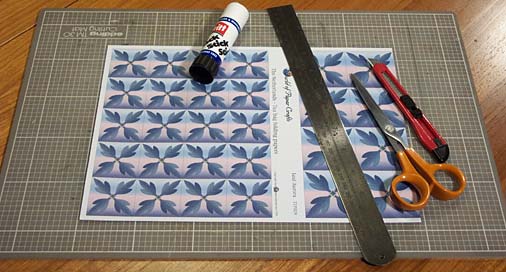
Equipment for tea bag folding together with a sheet of "Leaf Aurora" tea bag paper.
Equipment for tea bag folding.
- Cutting mat
- Metal edged ruler
- Craft knife
- Scissors
- Paper adhesive
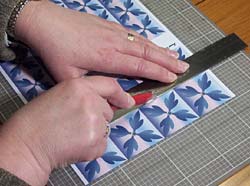 Lay your sheet of tea bag paper on your cutting board. Line up with the grid on the cutting board. Cut a strip of squares using a metal ruler and a craft knife.
Lay your sheet of tea bag paper on your cutting board. Line up with the grid on the cutting board. Cut a strip of squares using a metal ruler and a craft knife.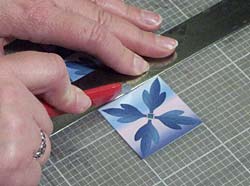 Cut a single square.
Cut a single square.Folding the paper.
On the diagram the green shaded areas represent the right side of the paper, the white areas the wrong side of the paper.The dotted lines represent folds you are about to make, the solid lines represent folds you have already made.
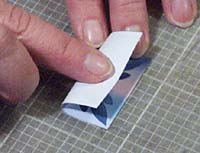
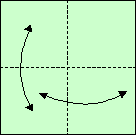 Step 1.
Step 1.In step 1 and 2 you are creating creases by folding and unfolding.
1. Fold the paper into half and then unfold it. Fold in half the other way and unfold it.
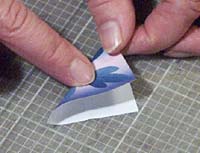
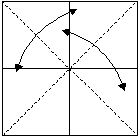 Step 2.
Step 2.2. Turn the paper over and fold from corner to corner then unfold it. Fold the other two corners together then unfold it.
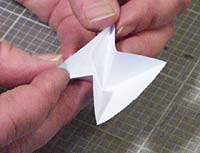
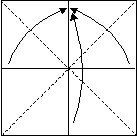 Step 3.
Step 3.3. Fold the lower half up and the outer edges into the centre, manipulating the creased paper into shape 4.
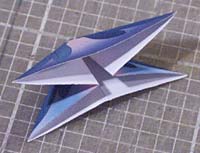
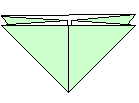 Step 4.
Step 4.Fold a total of eight shapes to this stage.
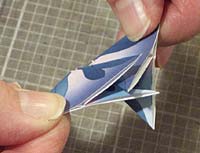
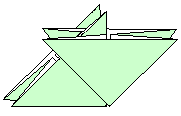 Step 5.
Step 5.5. Slide a second folded sheet between the V of the first shape. Note the way the V's of each piece go together.
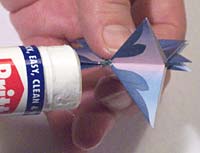 Fix the pieces with paper adhesive as you assemble the shape. If this is your first try it might be best to assemble it dry to start with, then fix it with adhesive when you are satisfied you have the correct method.
Fix the pieces with paper adhesive as you assemble the shape. If this is your first try it might be best to assemble it dry to start with, then fix it with adhesive when you are satisfied you have the correct method.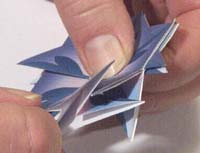 6. Continue sliding new pieces into the V of the previous piece until the design is complete.
6. Continue sliding new pieces into the V of the previous piece until the design is complete.The last piece of the set will take a bit of manipulation to get it into the correct position. Study the finished diagram to see how it should look.
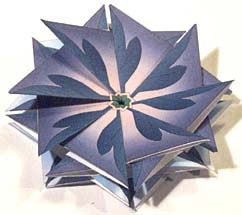
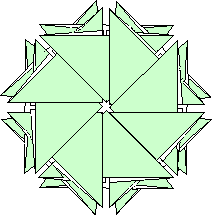
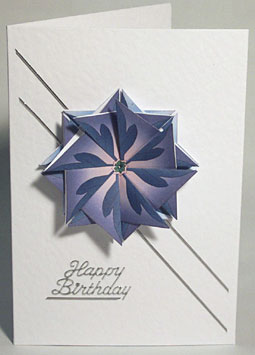
Subscribe to:
Posts (Atom)





